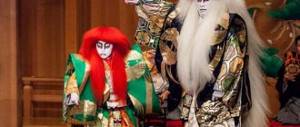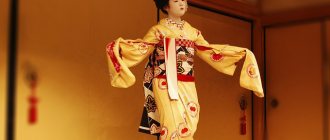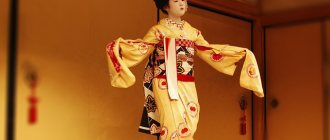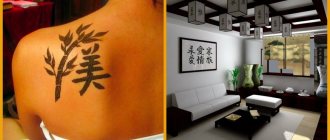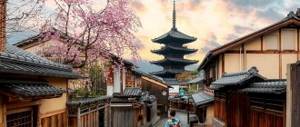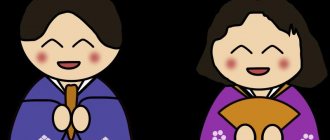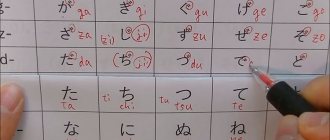For four centuries, Kabuki theater has not lost its popularity. Kabuki combines various genres of music and dance, and its distinctive feature is the exaggerated facial expressions of the actors.
Initially, kabuki performances were performed on the street, and it became a sensational genre for its time. Kabuki later moved to so-called tea theaters in the notorious red-light districts of growing cities. During the Edo period, one can clearly see an explicit erotic repertoire in Kabuki plays. Also, kabuki often adopted the themes of plays from a related form of theater, bunraku, and from the older form of Noh theater. During the golden age of kabuki (18th and 19th centuries), tea theaters grew in size and more complex techniques were used: revolving stages, lifts and multi-layered curtains. Thus, kabuki began to offer colorful panoramas, stage tricks, and changes in the shape of the scenery, which were not present in most forms of Asian theater, which mainly focused on the art of the actor.
The Birth of Kabuki
Kabuki, the national theater of Japan, originated quite a long time ago, back in the early 17th century.
Although its appearance was initially associated with performances for the benefit of temples, it quickly turned into a folk one. Not without the help of private patrons. Kabuki has long been synonymous with originality, color and immodesty. Kabuki dancers could be seen from afar: they were distinguished by hair that was not collected according to traditional Japanese canons, overseas crosses on their necks and a special style of gait. "Modern" in its truest sense.
The temple dancer Okuni laid the foundation for this type of theater. At first it was just dances, the most popular of which was nembutsu-odori - a Buddhist prayer dance.
Subsequently, she diversified her repertoire with Yayakko-odori and Oharagi-odori dances. For variety, Okuni periodically dressed as a man and acted out some scenes while dancing.
Women in the theater
The first kabuki performances were performed by women. In fact, the first movements in this direction became a breath of freedom for them, because in the Middle Ages they were deprived of any human rights.
But all good things come to an end quickly. Ladies of easy virtue adopted the theatrical performances of kabuki troupes and began to lure clients in the same spirit. The authorities did not put up with this state of affairs and quickly banned women from participating in kabuki.
This ban gave a powerful impetus to youth kabuki. During the heyday of the feminine, he was in the shadows, but then turned around to the fullest. It was practically no different from women's kabuki: young boys could easily pass for women in kimonos and makeup. And this, too, was not to the liking of the authorities, so youth kabuki was also banned.
The persecution continued during the existence of male kabuki. But with the help of the people he returned to the theater stage. It was precisely this zeal that made it a real folk theater and allowed it to survive to this day. Because the plays always emphasized sensitivity, the theater was constantly attacked, but this only strengthened it.
Leading theater characters
Kabuki characters can be divided into the following categories:
- "Tatiyaku" is a hero who can be described as a wise, handsome and brave man. He can be a fighter, a sophisticated handsome man, a hero-lover and a consummate warrior;
- "Katakiyaku" is a negative character who is the antagonist of tachiyaku in many plays. Usually, this is an evil and vile deceiver, but this character can also be revealed as a noble man who, because of his noble position, is forced to commit ugly acts;
- “Dokekata” is a comic character who in all plays is designed to make people laugh with his actions;
- "Koyaku" is a character performed by children;
- "Onnagata" is a female character whose role is played by a man. Onnagata can be of any age. Usually, the female image is shown in a long-sleeved kimono. Onnagata can be a noble lady or a beautiful courtesan. Could be a warrior's girlfriend or a merchant's wife.
Kabuki characters are bright and expressive. Each of them has its own distinctive features, strictly regulated by the canons of the genre.
The rise of folk theater
During the Genroku period, kabuki began to flourish on a large scale. The privileged classes lost power, and the middle strata of townspeople took their place, supporting the art that they liked.
During the same period, a manifesto for the independence of playwrights was created. Now plays could not be created and changed by actors. They acquired the status of a full-fledged literary work and remained static.
Plays appeared about the suicide of unhappy lovers. Japanese Romeo and Juliet were praised by Tikamatsu. Coming from a samurai family, he romanticized them with sad but beautiful poems, which significantly influenced life situations. Youth suicide has become a real social problem.
The art of acting itself began to change. In Kyoto theaters there has been a transition from excessive pretense to realistic behavior. One of the famous actors who switched to this style of acting was Sakata Tojuro. He had enough opponents among his colleagues, from whom he literally “snatched” the viewer’s attention, but the critics liked him.
A completely different development took place in Edo, which was known as the city of samurai. An important artist there was Ichikawa Danjuro. He is responsible for the origin of the Aragoto acting style - a heroic-romantic, formalist style.
This was the same time when the kabuki theater was divided into two branches and began to develop in two directions at once. The Kamigata school (according to Kyoto and Osaka) and the Edo school were formed.
However, the Kamigata school never developed into a theater of realistic drama. People who paid their hard-earned money for the performances wanted to see the show as in the “fun quarters”, and not to think about serious productions.
Material taken from the book “Japanese Theater” author: Grigory Chkhartishvili Throughout the 17th century, bourgeois literature and bourgeois painting arose, but the first to appear was bourgeois theater, the simplest and most accessible of the mass forms of art, which has always enjoyed the special love of the people. Exquisite, but it was too complicated for the townspeople, and few could attend the performances.
Since commoners were not allowed into the aristocratic theater, they acquired their own, plebeian, and not even one, but two - Kabuki and Bunraku. The first is an acting theater, the second is a puppet theater. They are usually considered together, since Kabuki and Bunraku most often use the same plays, adapted to the specifics of the genre. The best Kabuki dramas were originally written for the puppet theater, and Bunraku willingly enriched his repertoire with plays intended for acting. The only difference is that in Bunraku the text is read by a special gidayu reader, while in Kabuki it is read by the characters themselves.
But now we will focus on only one thing - Kabuki. The time of Kabuki's origin is known to within a year. Paradoxically, the theater, famous for the fact that there is no place for women in it, traces its ancestry precisely from women. In 1603 (this is the year when the unification of Japan was completed and Ieyasu became the first shogun of the Tokugawa dynasty), the Shinto priestess and famous performer of religious dances O-Kuni came on tour to Kyoto. Her outfit was defiantly bright, her movements were daring and even obscene. The intrigued public called this performance the word kabuki, which in that era meant everything unusual and extravagant. Subsequently, a homonymous spelling was chosen for the name of the theater in hieroglyphs ka (song);, bu (dance); and ki (skill). So the literal translation is “The Mastery of Singing and Dancing.”
Developing success, O-Kuni recruited a troupe of pretty and lively girls who began performing songs, dances and comic skits, often with erotic content. In a country where the long-awaited peace had finally been established, the thirst for entertainment was truly insatiable, and the O-Kuni Theater (O-Kuni-kabuki) was on everyone's lips. The girls combined performing on stage with selling their bodies, and both of these activities complemented each other perfectly. Enterprising brothel owners immediately appreciated the benefits of such a combination and began to create their own troupes. For a quarter of a century, these performances (they were called yujo-kabuki, “Kabuki of the Courtesans”) were extremely popular. Then the government, fighting immorality, banned women from performing on stage. It turned out even worse.
The public's interest in light theater developed to such an extent that profit-hungry entrepreneurs decided to replace the actresses with handsome, effeminate young men, and a real epidemic of homosexuality began among the townspeople, which previously existed mainly among the nobility and the clergy. The kabuki of this period were called wakashu-kabuki (“Youth Kabuki”), which is where the famous tradition of onnagata, or actors specializing in female roles, originated. In 1652, by a special decree, young men were prohibited from performing in Kabuki, but the theater was already firmly on its feet and easily withstood a new blow. Today's viewers, who perceive Kabuki as stylized and certainly not realistic theater, find it difficult to imagine that it was once considered a symbol of democracy and truth in life.
It was living, moving, sensual, and most importantly earthly art - as opposed to heavenly No. Democratic, independent Kabuki was constantly persecuted by the government, because the firm government cannot tolerate the free expression of feelings, seeing this as a dangerous symptom of lack of control and an attack on the foundations. But the lower classes of the rigidly structured Tokugawa society, for whom the bourgeois theater was the main spectacle and almost the only emotional outlet, loved Kabuki and Bunraku (puppet theater) with all their hearts and were ready to pay considerable money for admission for a poor person. For two hundred years there was an ongoing struggle between Kabuki and the shogunate. The government did not dare to close the theater completely, for fear of causing unrest, but there was no end to the harassment and petty quibbles.
In Edo (now Tokyo), all theaters had to be crowded into one block, which turned into a kind of acting ghetto. The fact is that the craft of an actor was considered despicable; actors were forbidden to wear ordinary clothes and were forbidden to leave the theater district. As a result, the Asakusa area, where all Edo theaters were concentrated, became the nerve center of metropolitan life. The so-called shibaijaya (“theater tea houses”) appeared, the prototype of theater coffee houses, where one could meet before the performance, have a feast after its end, discuss the latest news, make a date, etc. In an extremely regulated hierarchical society, the theater district was an island of freedom, where class differences did not matter.
Initially, Kabuki plays took place on the street, on a stage open on three sides, but gradually the action moved indoors. Kabuki actors were in the spotlight and enjoyed no less popularity than Hollywood stars in the 20th century.
There were numerous gossips and legends about them; every appearance of a favorite in public immediately attracted a crowd. The bourgeois theater also had many fans among the samurai. Men of noble rank entered performances without difficulty - it was enough to change clothes; if exposed, the offender faced serious trouble, but this stopped few people. It was more difficult for the ladies who were forced to adore famous actors in absentia. They resorted to incredible tricks in order to even catch a glimpse of the famous Ichikawa Danjuro the First or his rival Sakata Tojuro on the street, from the palanquin.
Of course, there were also melodramatic stories that excited the imagination of the public and over the decades acquired more and more new details. In 1714, the idol of the audience, Ikushima Shingoro, was sent into twenty-year exile for having a love affair with a high-born lady. The theater was demolished, the actors were expelled from the capital, the lady herself was expelled, and her older brother, who did not keep track of the sinner, was even put to death.
Officially at the lowest level of society (except for the untouchable caste), the leading Kabuki actors were the most famous people of their time, swimming in money and often astonishing audiences with their extravagant antics. Since the title of the leading actor in combination with the first and last name was inherited, over time a kind of clan aristocracy was formed in Kabuki, calling themselves in the royal manner - with a serial number, for example, Morita Kanya Thirteenth or Nakamura Kanzaburo Seventeenth (although the practice was widely used in Japan adoption, so succession was not always blood).
Since the beginning of the 18th century, there have been two Kabuki capitals - Edo (Tokyo) and Osaka-Kyoto. In Edo, a significant part of the population was the service class, so the Edo people preferred samurai drama with duels and battles. Superman heroes were especially loved; their playing style was called aragato (“sharp, rough style”). In the Osaka-Kyoto region, where the audience consisted entirely of merchants and artisans, the tone was set by lovers of sentimental melodrama about strong feelings, fatal love and crimes of passion. Actors of the gracefully romantic style, called vagoto (“peaceful style”), were honored. Osaka Kabuki was more realistic, Edo Kabuki was more colorful and effective.
The government could no longer resist the attractive power of mass theater, which enjoyed universal love. By the end of the 18th century, persecution of Kabuki almost ceased and the theater reached its heyday. For the last hundred years before the abolition of the isolationist course (Japan resumed contacts with the outside world in 1853), Kabuki reigned supreme in the minds and hearts of the population.
The shoguns invite actors to their castle and generously reward them for their performances. During this period, the theater rests on its laurels and seems to freeze in development, sinking into routine. The drastic change in the entire structure of social life that occurred as a result of Westernization and the social revolution of the mid-19th century breaks the living connection between the traditional theater and the audience. Kabuki is beginning to be perceived as an anachronism; playwrights and audiences are drawn to the new, fresh, unusual. A craze for Western theatrical forms begins.
Kabuki is trying to adapt to new trends. Theater buildings are being rebuilt in a European style, with chairs and gas lamps appearing in the hall. In 1887, the Kabuki performance was attended by the Emperor and Empress, raising the prestige of this once plebeian spectacle to unprecedented heights.
The attempt to transform Kabuki, undertaken at the end of the last century, is usually associated with the names of the owner of the Morita-za theater, Morita Kanya the Twelfth (1845-1897), the owner of the Meiji-za theater, Ichikawa Sadanji the First (1842-1904), and the actors Ichikawa Danjuro the Ninth (1838-1903) and Onoe Kikugoro the Fifth (1844-1903).
These theater workers updated their repertoire, tried to make the action as realistic as possible, and even staged performances on social themes, so fashionable at the turn of the century. By a sad coincidence, all four reformers passed away almost simultaneously, and their work remained unfinished.
In the twenties, Kabuki came under the influence of the giant of the entertainment industry, the Shochiku concern, which deprived the troupe of its former independence, but helped the theater survive and get back on its feet after the terrible earthquake of 1923, when all of Tokyo was turned into ruins. Kabuki was experiencing a crisis - financial, repertoire, and performing.
Strict adherence to acting continuity also has its negative side. A great talent cannot exactly cover ten or fifteen generations of the same family in a row, so it often turned out that the leading roles went not to the most talented, but to the most well-born, and it was very difficult for an actor in the first generation, even a very capable one, to get to the top in Kabuki - he could have been stuck for life in the role of “the hind legs of a horse” (a horse in Kabuki is traditionally portrayed by two extras, and they do it masterfully. The theater has a serious problem with the recruitment of supporting actors, who make up the majority of the troupe.
In the post-war period, Kabuki, like other genres of medieval art, regained a wide audience. It turned out that Western and Japanese theater can get along well with each other; for this they do not necessarily have to merge or displace each other. True, today Kabuki is perceived by Japanese audiences quite differently than in former times. The former plebeian theater became a refined and aristocratic spectacle, in need of a prepared and educated viewer.
Ritual
The Kabuki canon is no less strict and static than that of the Noh theater. Knowledge of the ritual and strict adherence to all its regulations, including those that have long lost their original practical meaning, are of particular importance: the viewer feels not only participation in art, but also participation in history; a special, unique aura of Edo life covers not only the stage, but also the hall, a magical gap in time occurs, and this effect is so strong that even a foreigner who comes to such a performance for the first time feels it.
There are no chairs in this theater; the audience sits on zabutons (flat cushions for sitting), they are stacked in multi-colored piles.
As soon as entering the Kabuki hall, the viewer immediately finds himself in a different historical dimension. At the beginning of the action, the loud clatter of wooden mallets is heard, and a man in black runs across the stage, dragging behind him a three-color curtain, the design of which has not changed for three hundred years. The scenery is amazing in its complexity and ingenuity. From the left edge of the stage, a narrow hanamichi (“flower path”) stretches into the hall. Once upon a time, offerings and gifts to actors were placed on it; later, hanamichi began to be used as an extension of the stage, which made it possible to take the action directly into the hall. This feature of Kabuki was adopted by many European theaters in the 20th century. Without Hanamichi, a genuine Kabuki performance is unthinkable.
What does such a move through the ground give? First of all, it provides an additional platform for the actor’s play, and even a platform that provides the actor with a number of opportunities that the stage can never provide.
After all, being on Hanamichi, he is in the middle of the auditorium, he is in the center of the spectator element, he is completely in front of the audience. This is very dangerous for an actor, but also very tempting. After all, it is here, in the auditorium itself, face to face with a thousand people unknown to him, who are now ready to either applaud him or shush him, that he can develop all his acting skills, can show himself, his trained body, his movement, his gesture , your facial expressions. The situation of one against a thousand - without the help of scenery, things, a ramp - forces him to mobilize all his technical and emotional power.
The presence of hanamichi also determines a number of purely production effects. Some episodes follow this path entirely. Often a combined play of scene and path is given. Sometimes the action moves systematically from the stage to the path and back.
There are times when a second path is built on the right side. Then we can observe an interesting example of parallel play: the actor on the left path and the actor on the right play in strict rhythmic and plastic correspondence. When the stage area is also included, the viewer is presented with a spectacle of exceptional compositional complexity.
There are no real horses in Kabuki. They are played by actors. Sometime in the beginning, they tried to adapt real horses for the theater. But one day the platform collapsed. The horse got scared and there was a commotion. Since then, horses have not been allowed on the Kabuki stage.
Another important invention appeared in Kabuki - a rotating stage (mawari butai), first tested back in 1758, and in Europe introduced by Vsevolod Meyerhold, a big fan of Japanese theater.
The Kabuki stage is low and flat, but part of it can be raised if necessary. Musicians and singers are placed on a special two-stage platform.
Another feature is the presence on stage of people in black, kurogo, who take away and bring props, help the actors untie the costume, but are considered invisible. These are theatrical servants. Also, in certain places of the performance, a man dressed in black will come out of the side curtains with two mallets in his hands: he will immediately squat down and, carefully watching the movements of the actors, begin to loudly knock with these mallets on the board on the floor. This is a special signaller. It lets the audience know that something very important, very significant is happening now. On the other hand, he helps the actor: with his blows he gives time to his movement, his pantomimic play. The episode ends, and the black man disappears backstage.
On both sides of the stage area, right next to the ramp, two portals are located somewhat obliquely. They look like boxes, usually covered with a transparent curtain - a lattice made of thin bamboo plates. Sometimes these portals are two-tiered, i.e. the boxes are located one above the other. It happens that the lattice curtains are raised, and everything in these boxes is right before the viewer’s eyes. There are musicians in these boxes. And since music in Japan is usually combined with singing, that means singers.
Here in the side box sits such a singer in a proud and motionless pose; Next to him is his companion, a musician, with a three-string shamisen in his hands. There is some particularly significant episode on stage: either a violent explosion of passions, or a profound experience, or a meaningful pause.
The tension of the action is so strong that the expressive means provided by the actor’s performance alone are not enough. And the tension spills over into another area - into music. A duet of voice and instrument sounds: the sounds of either a battle song, or a heroic ballad, or a lyrical aria, or an elegiac cantilena are heard. Revealing the action along the way, giving a prelude, postlude and interlude - these are the multifaceted tasks of music on the Kabuki stage.
But this is not enough. The sounds of shamisen are often heard during the action itself. They can be a simple accompaniment, or they can have another meaning: the clanking of the shamisen forms the rhythmic fabric of the action, organizes its tempo, puts it on a musical basis, and finally gives signals to the actors. In Japan they say: shamisen is the main director of the play. It would be more accurate to say differently: the main organizing principle of a Kabuki performance is music.
In Kabuki, the actors recite the text in a sing-song manner, with rhythm and often accompanied by musical accompaniment. Dramas derived from Bunraku (puppet theater) even have a narrator (tayu) describing off-stage events and the characters' feelings. Voice control is an art no less complex than bel canto. The actor must master two performing manners - “historical” (guttural recitation used in historical plays) and “everyday” (less pretentious manner imitating ordinary conversation).
In Kabuki, each role is prescribed its own style of performance and voice modulation, its own costume, and its own makeup.
Tachiyaku is a noble hero, he is divided into three types: 1) jitsugoto - sage 2) aragoto - warrior 3) vagoto - hero-lover
Villains are called katakiyaku and are divided into “real villains” (jitsuaku), aristocratic villains (kugeaku), treacherous seducers (iroaku), and so on.
Comic characters have two colors - positive (dokekata) and negative (handokataki). The performances often feature children of actors who have been accustomed to life on stage from an early age. Their role is called koyaku.
But the most famous role is onnagata or oyamya, female roles played by men. The ban on the participation of women in Kabuki was lifted more than a hundred years ago, but repeated attempts to introduce actresses into the performance of traditional theater did not meet with public support.
The point, of course, is a purely Japanese commitment to tradition, but, to an even greater extent, the inviolability of this outlandish role from a modern point of view is explained by the high art of onnagata actors, whose performance is perhaps the main charm of Kabuki. We often hear that it was the onnagata who preserved the Japanese ideal of female beauty and grace, since real Japanese women became coarser and Americanized.
In fact, onnagata were so able to transform into a woman, to become more feminine than a woman, that for centuries (even before any Americanization) they were the trendsetters of women's outfits, hairstyles, etc. in former times, onnagata were required to behave and dress like a woman off stage, so as not to go out of character. This, however, did not prevent female actors from starting families, otherwise the famous onnagata dynasties such as Nakamura Utaemon or Onoe Baiko would not have arisen.
The roles of onnagata reflect the entire spectrum of female roles, largely coinciding with the classification of female dolls in Bunraku: there is an ingenue (musumekata) and a villainess (akufu), as many as two femme fatales - high-born (akahime) and low-born (keisei), an old woman, a merchant's wife , faithful and unfaithful wives, warriors.
Each role in Kabuki corresponds to a certain kumadori makeup, which over the past centuries has also turned into a real art. Kumadori gives the key to the essence of the character, because it is not imposed arbitrarily, but again according to the canon. A special feature of men's makeup is the application of colored lines to the face, each of which has a special meaning.
For example, red indicates courage, kindness and passion of nature, and blue indicates malice and cowardice, sometimes of supernatural origin. Onnagata's face and hands are whitened, after which they use makeup that differs little from ordinary theatrical makeup, except that by Western standards it is somewhat exaggerated. In general, female characters, despite being played by men, look much more realistic on stage than male ones.
The arsenal of Kabuki stage techniques is very rich, but does not allow for any innovations. The techniques, as in Noh, are called kata (“form”, “posture”, all of them have been practiced over many generations. Action dramas certainly have one or more episodes with tachimawari - a stylized fight, where every movement of the combatants resembles a complex ballet.
The actor must be able to fence and master acrobatic art. Particularly impressive is the tombogaeri, a jumping somersault. An instant change in the hero's appearance is achieved with the help of hikinuki - the lightning-fast pulling off of a suit, under which another suit appears.
But most of all, viewers love mie - fixing a pose at the climax of an action or at the first appearance of an important character. This is a kind of freeze frame, giving the audience the opportunity to enjoy the effect and fully express their delight. Sometimes mie can be multi-figured.
Kabuki is a whole world with its own laws, superstitions and prejudices, the power of which extends beyond the stage. The troupe formed a complex hierarchy of ranks, somewhat reminiscent of the Soviet theater with “honored” artists of different ranks.
At the head of the troupe was zagashira (“the head of the theater”), then, in descending order, they went: murui (“incomparable”), shingoku-jojo-kichi (“really the best of the good”), daijojo-kichi (“the great best of the good” ), kojojo-kichi (“small best of the good”), simply jojo-kichi (“best of the good”). Simply “the best of the good”, actors of the seventh rank, constituted a numerous, but by no means the last link in the hierarchy.
Many customs are still alive today - for example, a funny fine imposed on an actor who made some mistake on stage. The offender must treat each actor who was involved in the episode with a bowl of noodles. If the stage was big, the fine is serious.
Decline and problems of kabuki
After prosperity inevitably comes decline, and this is what happened with the Kabuki theater. The change of power, the people's dissatisfaction with the new ruler and his laws resulted in riots, the closure of many theaters, and a revision of social situations. The suicide of lovers has ceased to be in fashion, being subjected to conceivable and unimaginable punishments and censures.
The theater fell into disrepair, the actors were treated like the lower classes. Actors who inherited the craft from father to son literally fell into slavish dependence on theater owners. Kabuki gradually moved from everyday scenes to mystical and fantastic plays.
The development of puppet theater ningyo joruri notably competed with kabuki, displacing it from the stage. However, this only gave a new impetus to development. In addition, there was a lot to learn from the puppet theater. Using it, kabuki was enriched with new themes for plays and new solutions in stage design.
The most common instrument during this period was the shamisen. The craze for music brought an innovation to the kabuki theater - setting dance plays. By the way, onnagata, the performers of female roles, were supposed to participate in the dance itself. But Nakamura Nakazo violated this principle, turning the robber into a ronnin (samurai left without a master), degraded and outraged by the power. He was the only one who decided to move in this direction. He had no followers.
What is this?
Kabuki is an art form rich in spectacle. It includes elaborate costumes, eye-catching makeup, outlandish wigs and, perhaps most importantly, exaggerated actions performed by the actors. Highly stylized movements serve to convey meaning to the audience; this is especially important since it usually uses an old-fashioned form of Japanese, which is difficult for even Japanese people to fully understand.
Dynamic stage decorations, such as rotating platforms and trap doors, allow for rapid scene changes and help actors appear or disappear. Another feature of the kabuki stage is the footbridge (hanamichi) that leads across the audience, allowing dramatic entry or exit. The atmosphere is enhanced by live music performed using traditional instruments. These elements combine to produce a visually stunning and captivating performance.
Interior of a modern Kabuki theater
The plots are usually based on historical events, heart dramas, moral conflicts, love stories, tales of conspiracy tragedies, or other famous stories. A unique feature of a kabuki play is that it only shows part of the story that everyone knows (usually the best part). So to enhance your enjoyment, it would be a good idea to read a little about the story before attending the show. Some theaters have headsets for rent that provide English translations and explanations.
Feudalism is gathering clouds
The severity of feudalism at the end of the 18th century led to a very different direction in kabuki plays. In Edo, they returned to the realistic dramaturgy of Kamigata. Only suicides of lovers gave way to family dramas. The faithful wife decides to help her husband's career and leaves him, saying that she does not love him. A husband kills his wife in passion. Public tastes shifted towards murder. But the plays themselves moved away from the entertainment character, showing social injustice, abandonment of life goals, and despair.
This direction could not help but undermine the ideals that Edo actors had been pursuing for so long. The clash between Edo and Kyoto and Osaka turned out to be not only in art, but also in power and economics. This had certain consequences: the plays became abusive, and blackmail and extortion reigned outside the theater.
So in the play “Tokaido Yotsuya-kaidan” Tsuruya Namboku showed the life of a ronnin who makes a living by repairing umbrellas. But he wanted a carefree life, which only the path of evil could give him under feudalism. Which he stepped on.
The reforms carried out by the shogun only plunged society further into decline and chaos. It was decided to destroy the Kabuki theater building and ban performances. But one of the officials wisely moved the theater to the outskirts of the city.
During this difficult time for society and culture, theatrical productions were not distinguished by either high themes or special techniques. Kabuki increasingly became a mirror of a people trying to survive in troubled times. The plays of Kawata-ke Mokuami were especially popular.
They tried to amaze the audience with a special Edo dramaturgy, which increasingly included various tricks and unexpected turns. The purpose of representation is to find truth even in decline. So, for example, in the play “Sakura Sogo” a peasant revolt unfolds. The production was the result of a search for fresh trends, because previously kabuki did not reflect village life.
Mokuami also worked closely with kabuki actor Ichikawa Kodanji. In their joint work, they addressed bandits and high-road romantics, emphasizing the special beauty of evil. Thus, in “Kozaru Shichinosuke” women are raped, in “Murai Choan” a sadist kills his loved ones, and in “Ikakematsu” the hopelessness of the future is reflected.
Trends of the Meiji era
After the overthrow of the old government and the advent of the Meiji reform era, kabuki theater did not change much, although social rights were recognized for the actors. The theater staged ordinary everyday dramas, which could not compete with the Mokuami method brought to perfection and its psychological variations. Writers and actors understood little at that time the problems and movements of the masses, because fundamental changes in the country were not made by the hands of the people.
After some time, “living history plays” began to be in demand at the theater, mainly thanks to officials who visited Europe. Actor Danjuro Ten presented elaborate ancient ceremonies on stage and performed with exceptional finesse. The people's theater, as kabuki has always been, began to move into theater for the upper classes. Ordinary people didn't need sophistication and history, they wanted fun dancing.
Features of theatrical productions
All Kabuki plays are quite long in time. They can last more than 3 hours, and some productions have to be adapted for foreign audiences, cutting scenes and episodes. Today in the world there are three types of theatrical plays of this genre:
- Jidai-mono. Such plays look like historical productions, telling about the legends of the Sengoku period;
- Seva-mono. They are everyday ideas that are based on stories that arose after the Sengoku period;
- Sesagoto. Dance performances that perfectly reflect all the subtleties of national Japanese dance.
A standard play takes 5 acts. Most productions use Nagauto's lyrical songs as accompaniment.
The uniqueness of Japanese theater lies in its thoughtful symbolism. An incredible combination of musical and dance numbers is combined with dramatic performances by the actors. And complex makeup and technical effects give incredible results. This theater has gone through difficult times, but has retained its originality and popularity. Kabuki is an authentic Japanese art with a long history. Even a viewer inexperienced in theatrical productions notices how the action taking place on stage captivates from the very first minutes.
The Japanese Kabuki theater has a specificity that is not inherent in any other theater in the world. Kabuki is both a genre and a special structure of the theater itself, and strictly regulated actions on stage that make it possible to reflect the diversity of feelings and emotions embedded in the script.
Fatal XX century
The Japanese-Chinese and Russian-Japanese wars also dealt a big blow to kabuki. There was so much excitement around these events that it immediately spilled over into art: from newspaper articles to theater.
Plays for kabuki began to come not only from Mokuami and Kawatake, but also from other writers who had not previously been in any way connected with the theater. The Meijin version of kabuki theater finally disappeared in the first decade of the 20th century. The struggle between the Literary Society and the Free Theater was in full swing.
Gradually, kabuki began to lose its usual appearance: new acting techniques appeared that diluted the traditions of the old school. Moreover, it appeared, which took over all Tokyo theaters. Kabuki ceased to be a folk theater, finally becoming a commercial one.
Japan, which had long been isolated from the rest of the world, discovered many new things, including in art. The 20th century became fatal for the kabuki theater; it constantly had to fight with European types of theater: operetta, mass theater, cinema, etc. All this relegated it to the background, leaving it a small niche among other types of traditional theater: noo, bunraku and others .
Makeup and costumes
For kabuki main characters, the most common type of makeup is purely white makeup or makeup (kesho). It is the color of purity, sophistication and aristocracy. Many of the commoners, such as servants and peasants, wore more brownish makeup, imitating the tan of people who worked hard outdoors. White makeup is generally applied after shaving or applying white paste to the eyebrows (for onnagata actors, a red base is applied under a layer of white makeup). After this, the eyes are outlined, lips are painted and eyebrows are drawn high on the forehead (all this is done in black or red).
This type of makeup allows you to exaggerate and emphasize facial features in accordance with the Kabuki aesthetic. It also emphasizes facial expressions, which are very important in this Japanese type of theater, and also allows facial expressions to be clearly seen even by those in the back rows.
There are also several even more stylized specialty makeup looks. The most colorful and flashy of these is kumadori, a makeup style that evolved with the aragoto (energetic male characters). In kumadori, makeup is applied in lines that highlight the actor's facial features. Red lines usually represent a good character, while blue lines usually represent an evil character. Kabuki actors typically apply their own makeup.
Kabuki costumes are called isho. It is immediately worth emphasizing that the kabuki repertoire covers many types of performances: some of them tell the story of feudal intrigues of the past (jidamono), some depict everyday life in the Edo period (sevamono), and some depict ghosts and supernatural beings. Thus, kabuki also uses several types of costumes. The costumes of jidamono plays are reminiscent of the heavy dresses of old times and are similar to Noh costumes. Men often wear wide skirts, trousers and shoulder extensions.
Realistic Edo period costumes are used in shawamono plays. The most modest of them are the so-called “paper kimonos”, which indicate the poverty of the characters. The most luxurious are the costumes of the popular courtesans, which consist of several layers of kimono covered with a heavy cape. The low collar of the back of the kimono shows the neck, which the Japanese consider as a very erotic and piquant detail.
Costumes can have hidden meanings. Their color, and especially the details embroidered on them, always have a symbolic meaning. Simply by lifting the hem of a kimono or lifting up a sleeve, an actor can symbolize various situations. Thus, handling different types of costumes is an integral part of acting technique.
Special acting techniques and music
One of the most important special techniques of kabuki is mie, a sequence of sharp movements that culminates in the actor striking an expressive pose. At the same time, the actor also makes a stylized facial expression with closed eyes. Mie is usually performed by male actors, but a similar technique exists for women, although it is less stylized and does not involve bringing the eyes together. This technique is called kimari. There is also another special method - roppo (six directions). This is a stylized, exaggerated way of walking that is characteristic of the energetic male characters often found in Aragoto and Jidamono plays. Roppo is also characterized by sweeping arm movements and powerful high steps of the actor.
Fight scenes in kabuki are called tachimawari. At the same time, in kabuki, as in the Peking Opera of China, battle scenes clearly reflect martial arts techniques. However, in kabuki, the battle scenes are more stylized, in contrast to the fast and highly acrobatic fights of Chinese opera.
Even though tachimawari uses a lot of weapons and acrobatic somersaults, etc., these kabuki scenes are shown in slow motion to allow the audience to see all the details clearly. Usually the hero defeats his enemies with ostentatious ease, without even touching his opponents. Scenes like these are true masterpieces of group choreography.
Kabuki music styles
Kabuki uses a special style of shamisen - shared storytelling (gidayu), as well as several types of music, which is divided into two main categories: narrative katarimono and more lyrical utaimono. The former was formed from the stories and music of bunraku puppet theater, while the latter has its origins in several types of music that accompanied various dances.
The third type of music, Geza, is provided by musicians who sit hidden from the audience in a separate room to the right of the stage. The main instrument in kabuki is the three-stringed shamisen lute. However, the gyoza orchestra uses several other instruments in order to provide the effect of changing the atmosphere and special sound effects such as storms, rain, etc. In some pieces, especially dance pieces from the Noh repertoire, the orchestra and singers sit on platforms at the back of the stage. Kabuki also uses two types of wooden rattles for different purposes. An intense crescendo of ki hand clappers announces the start of performances, while tsure clappers are used to punctuate dramatic climaxes. These moments are also accompanied by loud cries of encouragement and satisfaction of “what the hell.”
Source Wikipedia and 4dancing.ru
